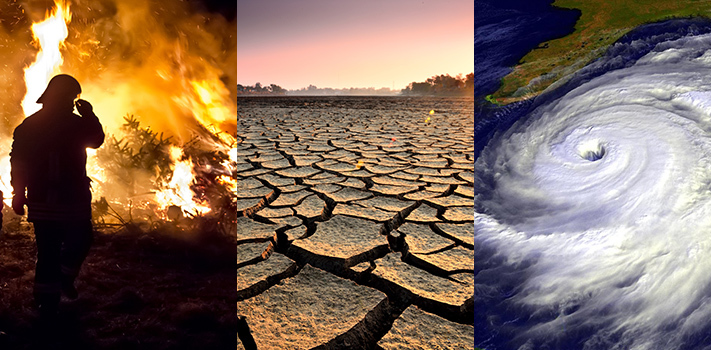Our unsustainable future and the need to do more
Recycling is great, but drastic action is needed if we are going to curb climate change
November 19, 2021
What’s the first thing you think of when you hear about environmental concerns? Is it climate change? Maybe you thought about deforestation or recycling. Or did you think about the masses of plastic accumulating on our planet?
That’s the problem with environmental concerns: there are so many of them that to even think of where to start helping, it can be overwhelming. It is such a complex issue that a lot of people push it completely out of their minds; we all might be guilty of it at times.
The largest environmental movement in our modern history began over fifty years ago with Earth Day, but the legacy of environmental reformers has existed long before that. Even in the early 20th century, the idea of conservation began when Theodore Roosevelt established national parks and acres of national forest. Before that, writings from as long ago as the seventh century contained ideas of environmentalism. Today, activists like Greta Thunberg lead school strikes in addition to other movements. So why has environmentalism been such a big topic for such a long time?
The problem lies in the impact humans have on the planet. The human footprint measures the amount of natural resources we use, whereas the planet’s total biocapacity is its ability to produce natural resources, absorb waste, and supply land. Right now, the combination of the planet’s human footprint and its biocapacity points to an unsustainable future. According to WWF, it would take 1.6 Earths to produce all of the resources humans use up. By 2050, this number could easily become two Earths.
With a planet of over seven billion people, it’s no wonder we go through resources so quickly. After all, think about the last time you went to a fast-food restaurant. How many resources do they use between plastic straws and cups? Add to that the population of people; there are at least 80 million Americans who eat fast food every day. Now add the fact that the laws that make restaurants dispose of extra food at the end of the day. That’s just one example of the resources we overuse on the planet—think of how many more there are. If you want to see your personal impact based on the amount of resources you use, visit http://www.footprintcalculator.org/home/en.
Similar to the idea of the human footprint is the carbon footprint. The carbon footprint represents the amount of carbon emitted by an activity, which then contributes to the human footprint. Greenhouse gases, like carbon dioxide, are necessary; however, when there is too much, it raises a problem. In fact, according to National Geographic, carbon dioxide emissions have been at an all-time high in recent years. This high amount of greenhouse gases leads to more heat being trapped, known as the greenhouse effect. Since the greenhouse effect changes our environment, the change that everyone has become familiar with is “climate change.” Climate change includes global warming, as well as changes in wildlife, extreme weather and rising seas. All of these changes have the potential to be dangerous and many can be attributed to human impact.
Mrs. Perkins, one of the teacher supervisors of the Environmental Club at RV, even had trouble nailing down a specific concern as they most important.
“Whatever we’re going to do to combat climate change, whether it be lowering emissions, reducing the amount of waste going into the air, proper farming, just reducing the amount of CO2 in the air, the heat on the west coast and all the water on the east coast, what are we going to do about that?” she said. “And that’s what you, young kids, are going to grow up to change.”
As Mrs. Perkins said, what are we going to do about that? Club officers of the Environmental Club, like senior Sarah Esmail, are a part of the next generation that can work on doing their part to protect the environment. “I definitely think [it’s important to] try reducing carbon emissions,” she said. “So try to maybe ride the bus instead of driving, and then substitute something plastic for something reusable.”
Mrs. Perkins and Mr. Green, the teachers that run the Environmental club, work together with their club officers to give kids the chance to get involved in the environment. Last year, during online Google meet sessions, officers were given the opportunity to present to the club topics of their interest. Perkins’ main focus is on recycling and TerraCycle. She also focuses on using reusable items, like the reusable bags you might see her carrying around in the halls at school. Almost weekly, the club meets at the annex building to do some gardening, which matches the interests of some other members.
“At the annex, we plant different seeds in the garden there, as well as in the greenhouse,” said junior Abby Nulph, a member of the Environmental Club. “We also planted elderberry trees and made some flowerbeds. And we are working on restoring the chicken coop for the new baby chicks we just got. I’m super excited for spring.”
Environmental Clubs are a great way to get involved in helping the environment, but there are many things you can do individually. Protecting the environment starts with us. Focusing on reducing, reusing and recycling is a great way to start. You can also participate in volunteer opportunities like the one Environmental Club recently had in October: the club went to LBI to help clean up the beach, where they collected trash items ranging from plastics to a firecracker.
Even if you can’t make it to a volunteering trip, changing small things in your life helps to prevent a build-up of a negative human footprint. Try reading some books on environmental issues, or going into more depth in articles about specific topics. The more educated we are, the more we can help our planet.
Like Greta Thunberg said, “You are never too small to make a difference.” The time to make a difference is now.






